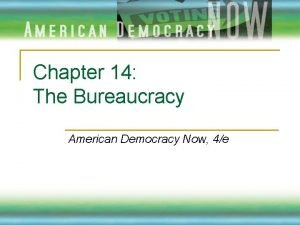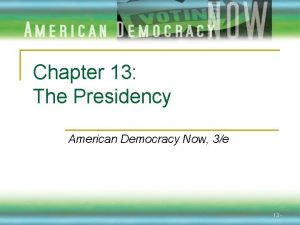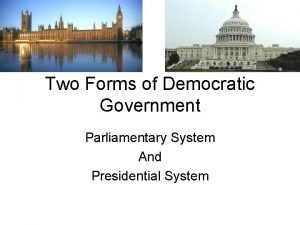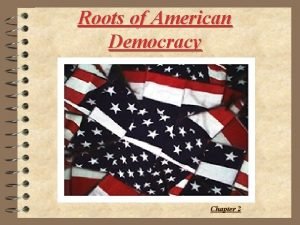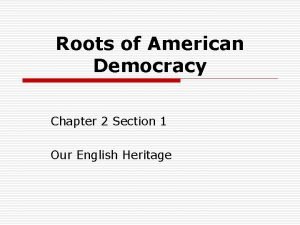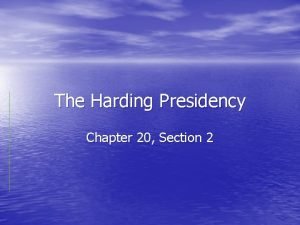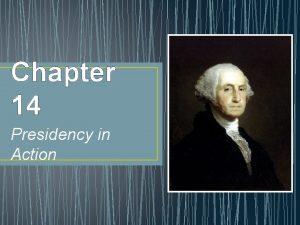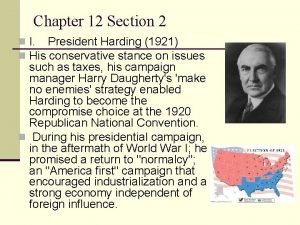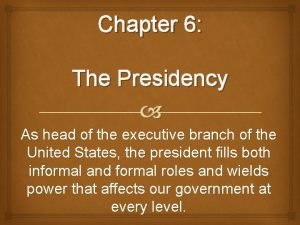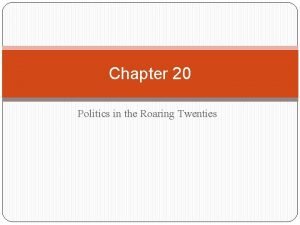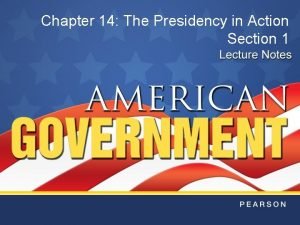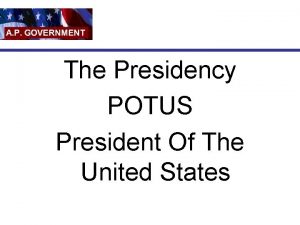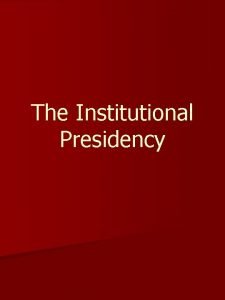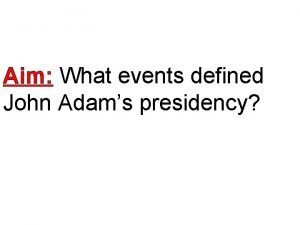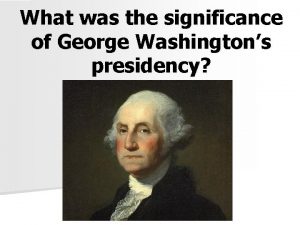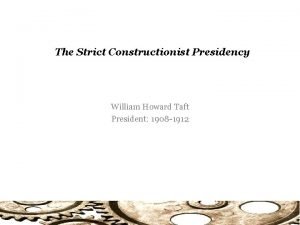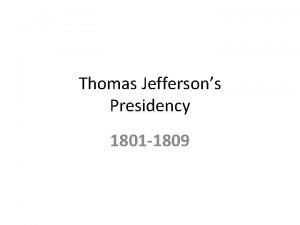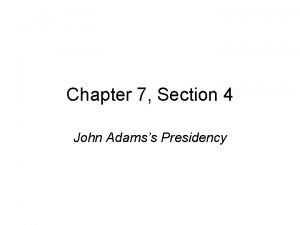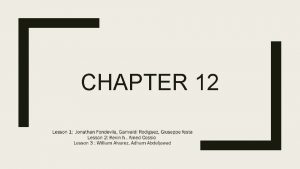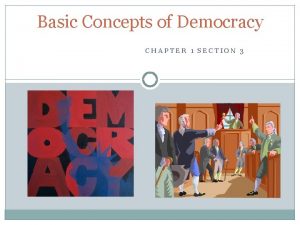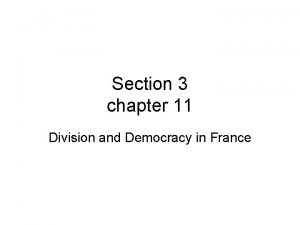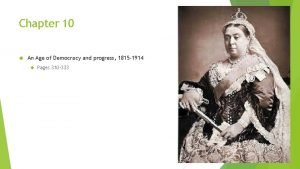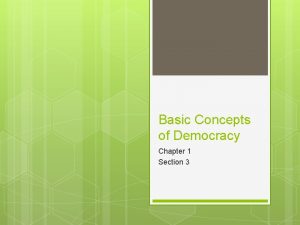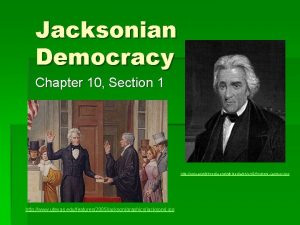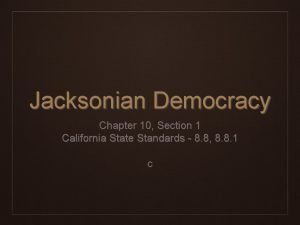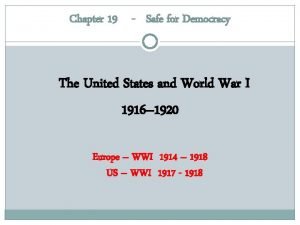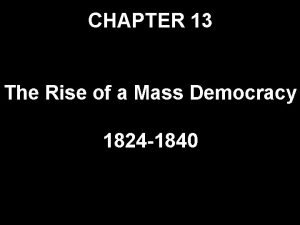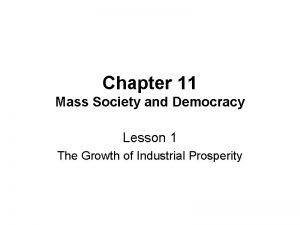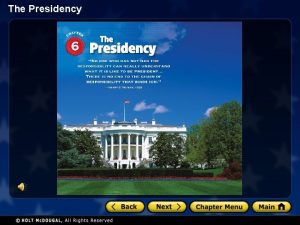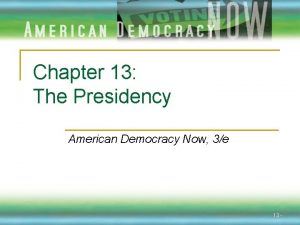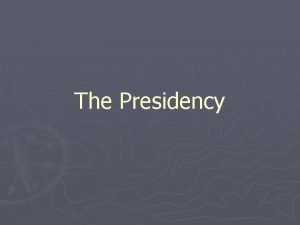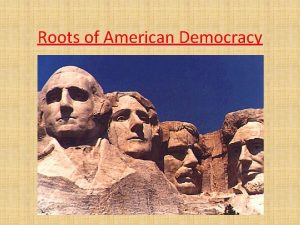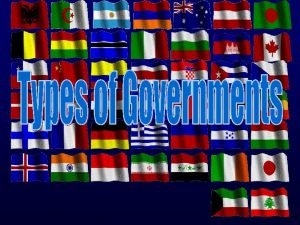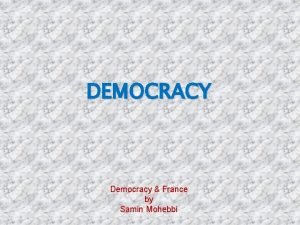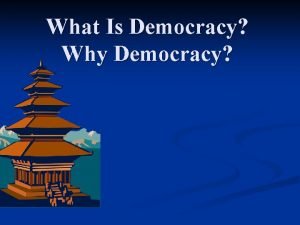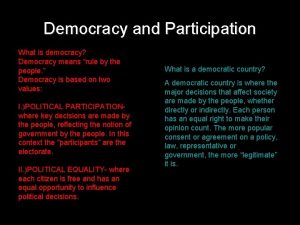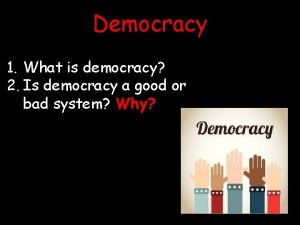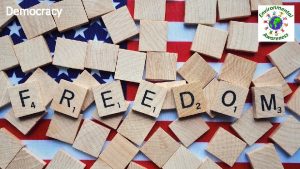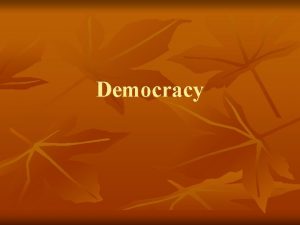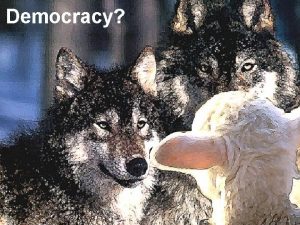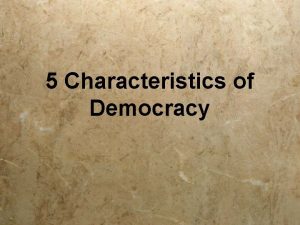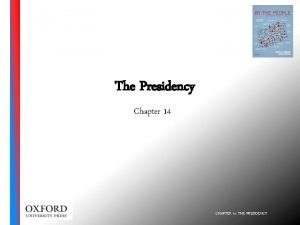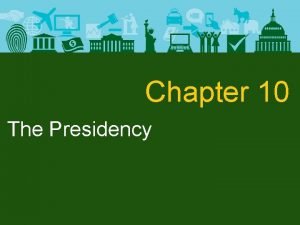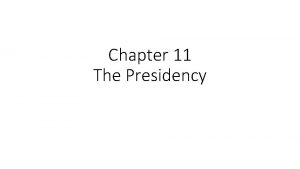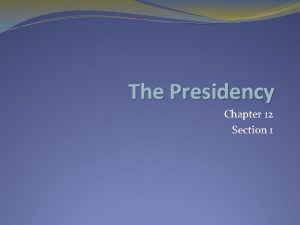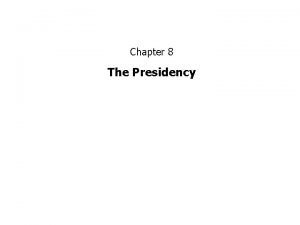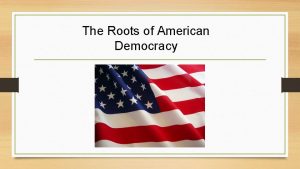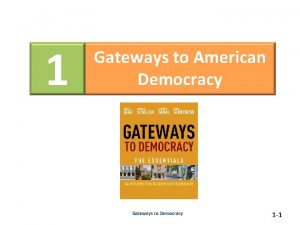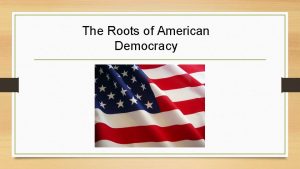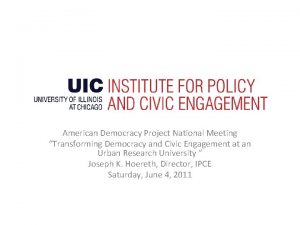Chapter 13 The Presidency American Democracy Now 3e


















































- Slides: 50

Chapter 13: The Presidency American Democracy Now, 3/e 13 -

Presidential Elections q q q Candidates position themselves years in advance of Election Day Eligible incumbent presidents are nearly always renominated Winner takes oath of office January 20 © 2013, The Mc. Graw-Hill Companies, Inc. All Rights Reserved. 13 -

Presidential Roles in the Domestic Sphere n As leaders in the domestic sphere, presidents must interact with Congress, manage the economy, and serve as the leader of their party. © 2013, The Mc. Graw-Hill Companies, Inc. All Rights Reserved. 13 -

Chief Legislator n n n Presidents can influence Congress by lobbying its members to support or oppose pending legislation and by defining the congressional agenda in the annual presidential State of the Union message. Presidents submit the budget for the entire federal government to Congress annually. One of the most important legislative tools at a president’s disposal is the authority either to sign legislation into law or to veto it. © 2013, The Mc. Graw-Hill Companies, Inc. All Rights Reserved. 13 -

Chief Legislator n n Modern presidents are generally much more likely to veto legislation than their predecessors were. A primary determinant of whether a president will regularly exercise veto power is whether the president’s party has a majority in Congress. President Bush used a different tactic—the signing statement—to put his mark on the way policies were to be administered during his tenure of office. A presidential signing statement is a written message that the president issues upon signing a bill into law. © 2013, The Mc. Graw-Hill Companies, Inc. All Rights Reserved. 13 -

Chief Economist n n n Presidents have numerous tools at their disposal that powerfully influence the country’s economic performance. By submitting a budget to Congress, presidents shape where federal tax dollars are spent, and thereby set the economic priorities of the legislative agenda. Presidents also help to establish the regulatory and economic environment in which businesses must operate. © 2013, The Mc. Graw-Hill Companies, Inc. All Rights Reserved. 13 -

Chief Economist n Central in presidents’ oversight of economic performance is the appointment of the Federal Reserve Board (“the Fed”) and its chair, who play a crucial role in managing the economy. © 2013, The Mc. Graw-Hill Companies, Inc. All Rights Reserved. 13 -

Party Leader n As chief of one of the two main parties, the president is a symbolic leader for the party members and asserts influence in the party’s operations by selecting the national party chair and serving as the party’s premier fund-raiser. © 2013, The Mc. Graw-Hill Companies, Inc. All Rights Reserved. 13 -

Presidential Roles in the Foreign Policy Sphere n The Constitution gives the president the authority with which to carry out the roles of chief diplomat and commander in chief of the U. S. armed forces. © 2013, The Mc. Graw-Hill Companies, Inc. All Rights Reserved. 13 -

Chief Diplomat n n Serving in the capacity of chief diplomat, the president (along with advisers) shapes and administers the nation’s foreign policy. As chief diplomat, the president, in conjunction with his or her staff, negotiates treaties and other international agreements with foreign. The president also has the authority to enter into an executive agreement. The Constitution also empowers the president to appoint ambassador to other nations. © 2013, The Mc. Graw-Hill Companies, Inc. All Rights Reserved. 13 -

Commander in Chief n n As commander in chief, the president is the supreme military commander of the U. S. Army, Navy, Air Force, Marines, and Coast Guard. Counseled by advisers, the president decides when to send troops into battle (although only Congress can formally declare war) and sets military strategy in times of both peace and war. © 2013, The Mc. Graw-Hill Companies, Inc. All Rights Reserved. 13 -

The Presidency Where Do You Stand? Is it a good idea or a bad idea for a president to meet with leaders of foreign countries that are widely viewed to be enemies of the United States? a. Good idea b. Bad idea Source: “Americans Favor President Meeting with U. S. Enemies, ” www. gallup. com/poll/107617/Americans-Favor-President-Meeting-USEnemies. aspx. © 2013, The Mc. Graw-Hill Companies, Inc. All Rights Reserved. 13 -

Overlap in the Domestic and Foreign Policy Roles: Chief Executive and Chief of State n n Some presidential functions overlap the domestic and foreign policy spheres. This spillover notably exists in the president’s role as chief executive—in which the president, as head of the executive branch, appoints advisers and staff —and the role of chief of state, the ceremonial function of the president. © 2013, The Mc. Graw-Hill Companies, Inc. All Rights Reserved. 13 -

Chief Executive n n The president appoints the secretaries (top administrators) of the cabinet—the 15 departments of the federal government—as well as the heads of other federal government agencies charged with developing and implementing the administration’s policy. The president also appoints other staff members and numerous advisers, including staff in the Executive Office of the President. © 2013, The Mc. Graw-Hill Companies, Inc. All Rights Reserved. 13 -

Chief Executive n The president determines how the bureaucracy will implement the laws Congress has passed and which will be emphasized. © 2013, The Mc. Graw-Hill Companies, Inc. All Rights Reserved. 13 -

Chief of State n n The function of chief of state is similar to the ceremonial role played by the constitutional monarch in parliamentary systems such as Great Britain’s. In the United States, the role of symbolic leader of the nation enhances the president’s image and authority and promotes national unity. © 2013, The Mc. Graw-Hill Companies, Inc. All Rights Reserved. 13 -

The President and the Executive Branch n n As chief executive, the president is constitutionally charged with ensuring that the “laws be faithfully executed. ” Today, this responsibility means that the president oversees a bureaucracy of more than 4 million government employees, including the members of the military, while presiding over an astonishing annual federal budget of nearly $4 trillion. © 2013, The Mc. Graw-Hill Companies, Inc. All Rights Reserved. 13 -

The Vice President’s Role n n John Nance Garner’s opinion on role. But vice presidents have an enormously important function. They are first in the line of succession to the presidency if the president should die or become incapacitated. Eight presidents have died while in office. © 2013, The Mc. Graw-Hill Companies, Inc. All Rights Reserved. 13 -

The Vice President’s Job n n Many vice presidents serve a largely ceremonial function. But vice presidents may have more substantive responsibilities, depending upon their skills and the needs of the administration. © 2013, The Mc. Graw-Hill Companies, Inc. All Rights Reserved. 13 -

Choosing a Vice President n n n In selecting a vice-presidential running mate, presidential candidates weigh several considerations. Would-be presidents strive for a balanced ticket. Or they may base their vice-presidential selection on their own shortcomings. . © 2013, The Mc. Graw-Hill Companies, Inc. All Rights Reserved. 13 -

The Cabinet n n Since George Washington’s presidency, every president has depended on the advice of a cabinet, the group of experts chosen by the president to serve as advisers on running the country. These advisers serve as the heads of each of the executive departments. Each president may also designate cabinet rank to other advisers whose agencies are not permanent cabinet departments. Increasingly, presidential cabinets have become more diverse. © 2013, The Mc. Graw-Hill Companies, Inc. All Rights Reserved. 13 -

The Executive Office of the President (EOP) n n The offices, councils, and boards that compose the EOP help the president to carry out the dayto-day responsibilities of the presidency and similarly assist the First Lady and the vice president in their official activities. The EOP also coordinates policies among different agencies and departments. © 2013, The Mc. Graw-Hill Companies, Inc. All Rights Reserved. 13 -

White House Office (WHO) n n WHO staff members develop policies favored by the presidential administration and protect the president’s legal and political interests. Among key WHO staff members are the chief of staff, press secretary and the White House counsel. © 2013, The Mc. Graw-Hill Companies, Inc. All Rights Reserved. 13 -

National Security Council (NSC) n n n The NSC advises presidents on key national security and foreign policy decisions and assisted in the implementation of those decisions by coordinating policy administration among different agencies. The president officially chairs the National Security Council. Its other regular members include the vice president, the secretary of defense, the secretary of state, the secretary of the treasury, and the assistant to the president for national security affairs, who is responsible for administering the day-to-day operations of the NSC and its staff. © 2013, The Mc. Graw-Hill Companies, Inc. All Rights Reserved. 13 -

Office of Management and Budget (OMB) n n Its chief responsibility is to create the president’s annual budget, which the president submits to Congress each January. Once Congress approves the budget, it is the job of the OMB to manage the budget’s execution by federal departments and agencies—to ensure that monies are spent on their designated purposes and that fraud and financial abuse do not occur. © 2013, The Mc. Graw-Hill Companies, Inc. All Rights Reserved. 13 -

Presidential Succession n n Presidential succession is determined by the Presidential Succession Law of 1947. But sometimes incapacitation other than death prevents presidents from fulfilling their duties. In such cases, the Twenty-Fifth Amendment, ratified in 1967, determines the course of action. © 2013, The Mc. Graw-Hill Companies, Inc. All Rights Reserved. 13 -

When the President Dies in Office n n When the president dies, the course of action is clear in most cases: the vice president assumes the presidency. The Presidential Succession Law of 1947 determines presidential succession if the vice president also dies or is unable to govern. © 2013, The Mc. Graw-Hill Companies, Inc. All Rights Reserved. 13 -

© 2013, The Mc. Graw-Hill Companies, Inc. All Rights Reserved. 13 -

When the President Cannot Serve: The Twenty-Fifth Amendment n n n According to the Twenty-Fifth Amendment, if a president believes he or she is unable to carry out the duties of the office, the president must notify Congress, and the vice president becomes the acting president until the president can resume authority. If the president is incapable of carrying out the duties of office and incapable of notifying Congress, the vice president and a majority of the cabinet notify Congress, and the vice president becomes the acting president. If a question arises as to whether the president is fit to reassume the duties of office, a two-thirds vote of Congress is required for the acting president to remain. © 2013, The Mc. Graw-Hill Companies, Inc. All Rights Reserved. 13 -

Sources of Presidential Power n n n The framers granted the presidents both expressed powers and inherent powers in the Constitution. Congress grants presidents additional powers, called statutory powers, through congressional action. Additional presidential powers have emerged over time, such as emergency powers, and informal powers bestowed through electoral mandate and presidential popularity. © 2013, The Mc. Graw-Hill Companies, Inc. All Rights Reserved. 13 -

The Constitution: Expressed Powers n n The primary source of presidential power comes from the Constitution in the form of the expressed powers, which are those enumerated in the Constitution. The expressed powers outlined in the Constitution provide a framework for presidential responsibilities and an outline of presidential power. © 2013, The Mc. Graw-Hill Companies, Inc. All Rights Reserved. 13 -

The Constitution: Inherent Powers n n The take care clause states that “the executive Power shall be vested in a President of the United States of America” and that “he shall take Care that the Laws be faithfully executed. ” On the basis of that clause, presidents throughout U. S. history have asserted various inherent powers, which are powers that are not expressly granted by the Constitution but are inferred. © 2013, The Mc. Graw-Hill Companies, Inc. All Rights Reserved. 13 -

Statutory Powers n n The Constitution’s expressed and inherent powers provided a foundation for presidential power that has evolved over time. Those powers have been supplemented by additional powers— powers explicitly granted to presidents by congressional action. © 2013, The Mc. Graw-Hill Companies, Inc. All Rights Reserved. 13 -

Special Presidential Powers n n n Presidents also have special powers that have evolved from various sources, including the Constitution, Supreme Court decisions, and congressional statutes. These powers, which numerous presidents have exercised, have come to be regarded as accepted powers and privileges of the presidency. They include executive orders, emergency powers, and executive privilege. © 2013, The Mc. Graw-Hill Companies, Inc. All Rights Reserved. 13 -

Executive Orders n n The president has the power to issue executive orders that have the force of law. In general, executive orders: q q direct the enforcement of congressional statutes or Supreme Court rulings enforce specific provisions of the Constitution guide the administration of treaties with foreign governments create or change the regulatory guidelines or practices of an executive department or agency © 2013, The Mc. Graw-Hill Companies, Inc. All Rights Reserved. 13 -

Emergency Powers n n Broad powers that a president exercises during times of national crisis have been invoked by presidents since Abraham Lincoln’s claim to emergency powers during the Civil War. In 1936, the U. S. Supreme Court acknowledged the existence of presidential emergency powers in United States v. Curtiss-Wright Export Corp. © 2013, The Mc. Graw-Hill Companies, Inc. All Rights Reserved. 13 -

Executive Privilege n n n Presidents also can exercise executive privilege, the authority of the president and other executive officials to refuse to disclose information concerning confidential conversations or national security to Congress or the courts. On occasion, the judicial branch of the federal government has successfully challenged executive privilege. In general, the courts have allowed executive privilege in cases where a clear issue of separation of powers exists. © 2013, The Mc. Graw-Hill Companies, Inc. All Rights Reserved. 13 -

The Presidency n The People as a Source of Presidential Power q q q The President and the Bully Pulpit The President and Public Approval The Media as a Tool of Presidential Influence © 2013, The Mc. Graw-Hill Companies, Inc. All Rights Reserved. 13 -

The People as a Source of Presidential Power n The presidents’ ability to wield their power, to control the political agenda, and to get things done typically is a function of political skill, charisma, and what political scientist Richard Neustadt has called “the power to persuade. ” © 2013, The Mc. Graw-Hill Companies, Inc. All Rights Reserved. 13 -

The President and the Bully Pulpit n n n Modern presidents work to persuade the public on a virtually continuous basis. In their efforts to persuade the people, they exploit the power of their office, using the presidency as a forum from which to speak out on any matter—and to have their views listened to. Richard Neustadt argues that the modern institution of the presidency is weak and that presidents in fact must rely on public and congressional support in order to enact their agendas. © 2013, The Mc. Graw-Hill Companies, Inc. All Rights Reserved. 13 -

The President and Public Approval n n Approval ratings are the percentage of survey respondents who say that they “approve” or “strongly approve” of the way the president is doing his job. The honeymoon period. The rally ’round the flag effect A president rarely sustains high public approval continuously. Once achieved, however, high ratings help the chief executive to achieve his goals by demonstrating the people’s support of the presidential agenda. © 2013, The Mc. Graw-Hill Companies, Inc. All Rights Reserved. 13 -

The Media as a Tool of Presidential Influence n n Modern presidents rely heavily on technology and the mass media to convey their message to the people. For every president, technology and the media can be used as a tool of influence as the expertise of the White House communications office can “spin” news in a favorable light for the administration. © 2013, The Mc. Graw-Hill Companies, Inc. All Rights Reserved. 13 -

The Evolution of Presidential Power q q q Early Presidents and the Scope of Presidential Power The Watershed 1970 s: The Pentagon Papers, Watergate, and the “Imperial Presidency” The Post-Watergate Presidency © 2013, The Mc. Graw-Hill Companies, Inc. All Rights Reserved. 13 -

Impeachment: A Check on Abuses of Presidential Power n n n One crucial check on presidential power is impeachment. Impeachable offenses include “Treason, Bribery, or other high Crimes and Misdemeanors. ” If a majority of the members of the House of Representatives vote to impeach the president, they forward the charges against the president, called the articles of impeachment, to the Senate. © 2013, The Mc. Graw-Hill Companies, Inc. All Rights Reserved. 13 -

Impeachment: A Check on Abuses of Presidential Power n n The Senate then tries the president and, in the event of conviction for the offenses (which requires the support of two-thirds of members), determines the penalty. In convicting a president, the Senate has the authority to punish the president by removing him from office. Two presidents have been impeached by the House of Representatives. None have been convicted and removed from office, although Nixon resigned from office to avoid the inevitable in the wake of the Watergate scandal. © 2013, The Mc. Graw-Hill Companies, Inc. All Rights Reserved. 13 -

The Presidency n Women in the White House q q The First Lady When a Woman Is Elected President © 2013, The Mc. Graw-Hill Companies, Inc. All Rights Reserved. 13 -

Women in the White House n n No woman served as a cabinet member until the twentieth century, and to date, a woman has not been elected president. Historically, the women who have served as First Lady have influenced both presidents and policy. © 2013, The Mc. Graw-Hill Companies, Inc. All Rights Reserved. 13 -

The First Lady n n n Much like the presidency itself, the office of the First Lady has been defined by the individuals who have occupied it. Michelle Obama has focused on raising the Obamas’ young daughters, and on the more ceremonial aspect of serving as First Lady (although she has also campaigned on issue of childhood obesity). Other First Ladies have used their proximity to the chief executive to influence policy concerns more broadly and more forcefully. © 2013, The Mc. Graw-Hill Companies, Inc. All Rights Reserved. 13 -

When a Woman Is Elected President n n There has been increased expressed willingness on the part of Americans to vote for a qualified woman president. Inevitably, the United States will have to face the issue of the role of the First Gentleman. © 2013, The Mc. Graw-Hill Companies, Inc. All Rights Reserved. 13 -

© 2013, The Mc. Graw-Hill Companies, Inc. All Rights Reserved. 13 -
 American democracy now chapter 14
American democracy now chapter 14 Chapter 13 the presidency
Chapter 13 the presidency Parliamentary system vs presidential system
Parliamentary system vs presidential system Chapter 2 roots of american democracy answers
Chapter 2 roots of american democracy answers Chapter 2 roots of american democracy answers
Chapter 2 roots of american democracy answers Chapter 12 section 2 the harding presidency
Chapter 12 section 2 the harding presidency President appointment power
President appointment power Chapter 6 section 1
Chapter 6 section 1 Ch 12 section 2 the harding presidency
Ch 12 section 2 the harding presidency President's formal and informal powers
President's formal and informal powers Chapter 20 politics of the roaring twenties answer key
Chapter 20 politics of the roaring twenties answer key Chapter 14 section 1 the growth of presidential power
Chapter 14 section 1 the growth of presidential power Now i see it now you don't
Now i see it now you don't Presidency line of succession
Presidency line of succession Institutional presidency definition
Institutional presidency definition What events happened during john adams presidency
What events happened during john adams presidency George washingtons presidency
George washingtons presidency Washingtons cabinet
Washingtons cabinet Constructionist theory president
Constructionist theory president Which trend characterized thomas jefferson's presidency?
Which trend characterized thomas jefferson's presidency? Thomas jeffersons presidency
Thomas jeffersons presidency Section 4 the presidency of john adams
Section 4 the presidency of john adams Chapter 7 citizen participation in a democracy answers
Chapter 7 citizen participation in a democracy answers Chapter 13 the rise of a mass democracy
Chapter 13 the rise of a mass democracy Chapter 12 lesson 1 jacksonian democracy
Chapter 12 lesson 1 jacksonian democracy Basic concepts of democracy chapter 1 section 3
Basic concepts of democracy chapter 1 section 3 Chapter 11 section 3 division and democracy in france
Chapter 11 section 3 division and democracy in france Chapter 10 an age of democracy and progress answer key
Chapter 10 an age of democracy and progress answer key Chapter 1 section 3 basic concepts of democracy
Chapter 1 section 3 basic concepts of democracy Chapter 10 section 1 jacksonian democracy
Chapter 10 section 1 jacksonian democracy Chapter 10 section 1 jacksonian democracy
Chapter 10 section 1 jacksonian democracy Chapter 19 safe for democracy
Chapter 19 safe for democracy Chapter 13 the rise of a mass democracy
Chapter 13 the rise of a mass democracy Mass society and democracy lesson 1
Mass society and democracy lesson 1 Hình ảnh bộ gõ cơ thể búng tay
Hình ảnh bộ gõ cơ thể búng tay Lp html
Lp html Bổ thể
Bổ thể Tỉ lệ cơ thể trẻ em
Tỉ lệ cơ thể trẻ em Chó sói
Chó sói Tư thế worms-breton
Tư thế worms-breton Chúa yêu trần thế alleluia
Chúa yêu trần thế alleluia Môn thể thao bắt đầu bằng chữ f
Môn thể thao bắt đầu bằng chữ f Thế nào là hệ số cao nhất
Thế nào là hệ số cao nhất Các châu lục và đại dương trên thế giới
Các châu lục và đại dương trên thế giới Công thức tiính động năng
Công thức tiính động năng Trời xanh đây là của chúng ta thể thơ
Trời xanh đây là của chúng ta thể thơ Mật thư anh em như thể tay chân
Mật thư anh em như thể tay chân 101012 bằng
101012 bằng Phản ứng thế ankan
Phản ứng thế ankan Các châu lục và đại dương trên thế giới
Các châu lục và đại dương trên thế giới Thơ thất ngôn tứ tuyệt đường luật
Thơ thất ngôn tứ tuyệt đường luật
